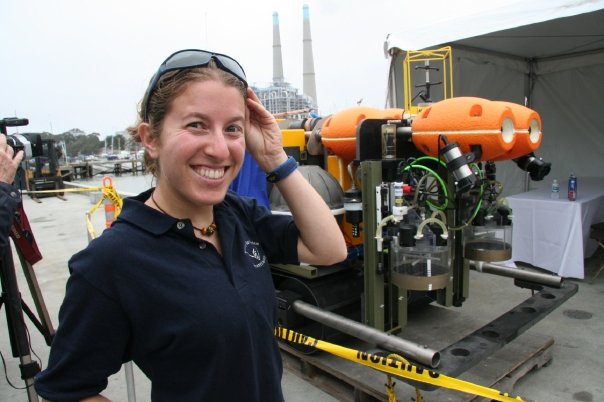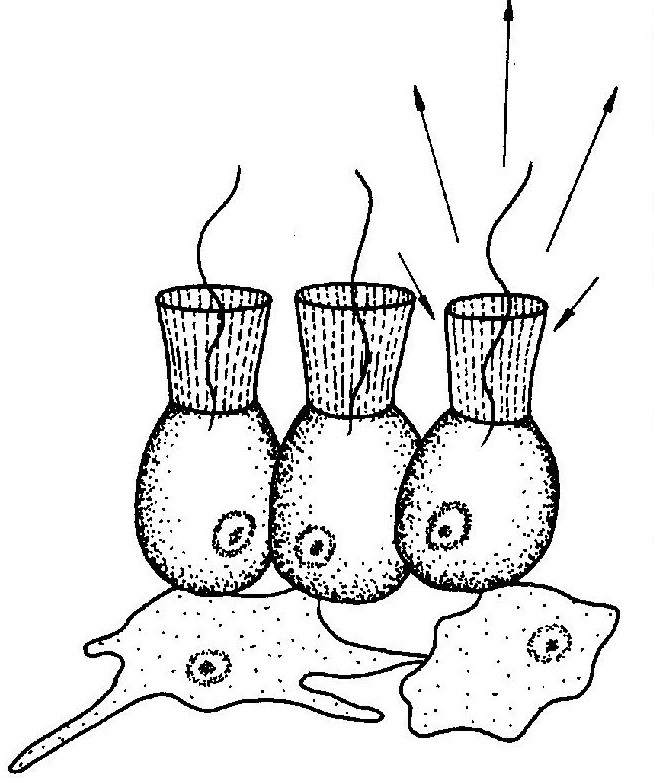
by Amanda Kahn, Invertebrate Zoology and Molecular Ecology Lab
Hi again. I received a few questions in my previous post that I would like to address in this post. A user named doughnutfan asked three great questions about sponges.
Q: Are the spicules themselves responsible for filtering out the food particles?
A: Sponge spicules do not filter food particles out of the water – what they do is support the cells that do. I often think of sponges as skyscrapers (yes, I really do); it makes it a lot easier to visualize what different body parts of sponges are good for. Spicules are like the beams and internal structures that support the skyscraper – they provide support and give the sponge its shape. Spicules also make sponges hard to eat; very few animals can handle passing glass shards through their digestive systems!
 Instead, what is responsible for filtering food out of the water is a type of cell called a choanocyte (ko-AN-oh-site). It looks like a funny name at first, but it’s named after a group of microscopic single-celled organisms called choanoflagellates. The choanocytes in sponges look just like the free-roaming choanoflagellates, but intsead of being solitary, single-celled organisms, sponge choanocytes are clustered together and work together to get food. As a side note, the strong similarity between the way choanoflagellates and sponge choanocytes is no coincidence. Currently, the favored hypothesis of how animals first evolved from single-celled organisms is that choanoflagellates evolved into sponges (specifically, the choanocytes in sponges). Sorry, back to the subject of feeding. Choanocytes are also called “collar cells” (that’s actually the Latin translation of choano + cyte) because they have a big, whip-like tail that sticks out called a flagellum, and that flagellum is surrounded by a “collar” of smaller fuzzies called microvilli. The flagellum keeps water moving through big chambers with tens to hundreds of choanocytes, and food particles get trapped on the microvilli. From there, the choanocytes eat the food, and then some of those nutrients are transported around to other, nonfeeding cells of the sponge. That’s right, there are nonfeeding cells in sponges as well – some are specialized for building new spicules, and others are specialized for transporting things from one cell to another.
Instead, what is responsible for filtering food out of the water is a type of cell called a choanocyte (ko-AN-oh-site). It looks like a funny name at first, but it’s named after a group of microscopic single-celled organisms called choanoflagellates. The choanocytes in sponges look just like the free-roaming choanoflagellates, but intsead of being solitary, single-celled organisms, sponge choanocytes are clustered together and work together to get food. As a side note, the strong similarity between the way choanoflagellates and sponge choanocytes is no coincidence. Currently, the favored hypothesis of how animals first evolved from single-celled organisms is that choanoflagellates evolved into sponges (specifically, the choanocytes in sponges). Sorry, back to the subject of feeding. Choanocytes are also called “collar cells” (that’s actually the Latin translation of choano + cyte) because they have a big, whip-like tail that sticks out called a flagellum, and that flagellum is surrounded by a “collar” of smaller fuzzies called microvilli. The flagellum keeps water moving through big chambers with tens to hundreds of choanocytes, and food particles get trapped on the microvilli. From there, the choanocytes eat the food, and then some of those nutrients are transported around to other, nonfeeding cells of the sponge. That’s right, there are nonfeeding cells in sponges as well – some are specialized for building new spicules, and others are specialized for transporting things from one cell to another.
Q: Do sponges have any kind of a central nervous system (I can’t imagine that sponges have brains!), or is the process purely mechanical?

A: No, sponges don’t have a central nervous system, or a nervous system of any kind. The first evidence of a nervous system in animals is in jellies, sea anemones, and other related animals, and also in comb jellies (which, in spite of the name, are very different from jellies). The primitive nervous system found in jellies and comb jellies is not centralized – it’s just a network of nerves that run through the jelly’s body, so if one nerve fires, the others will fire too, in a wave along the body.
Anyway, back to sponges. Instead of coordinating movements to get water to flow efficiently through a sponge’s aquiferous system (from my previous post, that’s a series of canals that go through a sponge’s body), sponges affect the water flowing through the aquiferous system in a different way. The structure of a sponge, which is built and maintained by spicules, takes advantage of the laws of physics to make water flow into the aquiferous system as quickly as possible, and slow down in places where choanocytes are picking through for food! I guess this shows that it doesn’t take a huge brain (or any brain) to understand physics! My physicist friend might not like that…
One last thing on this topic: there is one big class of sponges that might have something like a nervous system…which brings us to the last question:
Q: Do sponges have any kind of “skin” that surrounds their skeleton?
A: Yes! Well, no. Well, here’s the thing. Some do, and others do too, but in different ways. All sponges have stuff that grows among their spicule skeletons. Some have cells that hang along the edges of those spicules, while others have cells that are pierced right through with spicules. My favorite kind of sponge has something totally different. Are you ready for this? It’s called a syncytium. Yeah, try saying that three times fast. Or one, for that matter! It’s pronounced sin-SISH-um, and it’s a fancy name for a big sheet of…cellular matter, that is not separated out into individual cells. It’s a weird concept, but all syncytia (the plural form of syncytium) have lots of cell nuclei inside, even though there aren’t defined individual cells with cell membranes. The syncytium (I just love writing that word!) is really thin, and hangs along the framework made up by spicules. What makes it really cool is that a study found that sponges with a syncytium can conduct electrical currents across that syncytium, which may be the very early beginnings of a nervous system!
I hope this is all as exciting to you as it is to me. I don’t, after all, want to talk and talk and realize that I am as exciting as a wet sponge. Actually, now that I think about it, I would LOVE to be as exciting as wet sponge!


